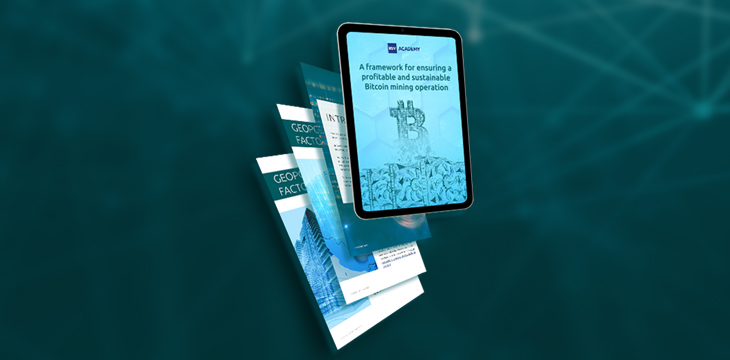|
Getting your Trinity Audio player ready...
|
The Bitcoin SV Academy has officially launched a new ebook titled, “A framework for ensuring a profitable and sustainable Bitcoin mining operation.” The ebook looks at everything from choosing an ASIC miner to how the climate and geopolitics of a location can impact a mining operation’s sustainability and bottom line.
In compiling the ebook, the Academy collaborated with Lars Jorgensen, Chief Operating Officer of TAAL Distributed Information Technologies Inc. (CSE:TAAL | FWB:9SQ1 | OTC: TAALF)., about what it takes to start and manage a profitable and sustainable block reward mining operation. It also published a blog post where Lars spoke about Bitcoin mining strategy, China’s Bitcoin mining ban, and greener mining.
How the bull market is stifling Bitcoin mining innovation
Jorgensen stated that the current bull market had created a seller’s market where miners feel little incentive to innovate. He said it’s difficult to see how mining hardware will evolve in current conditions.
At present, there are lots of small players aside from Bitmain and MicroBT, but Jorgensen feels they are playing a much larger role than they otherwise would. Noting that even Bitmain and MicroBT’s hardware is based on air cooling, Lars outlined how it’s possible to cool mining rigs via liquid immersion. He said that these immersive cooling techniques would significantly increase the efficiency of a mining operation. This could lead to (a) a significant increase in machine performance and/or (b) smaller costs related to cooling.
He believes that when coin prices drop and supply/demand dynamics change, miners will have to consider ideas like this to remain competitive. The bear market will force miners to reveal their secret weapons, Jorgensen said.
“I expect that once suppliers introduce new cooling systems, it will be tailored to work with their machines alone. You’ll need to buy the whole package from the same supplier, including the container, the liquid, the heat exchange mechanism, and other parts that make up the system,” he said.
Jorgensen also believes we’ll see manufacturers revealing cooling systems that are designed to work with their machines alone and DIY attempts to create immersion cooling systems. However, he warns that the DIY approach will almost certainly void warranties.
There are lots of other techniques aside from immersion cooling systems. You can read more about them in the eBook.
China’s Bitcoin mining ban and greener Bitcoin mining
Jorgensen noted that mining farms, some with hundreds and thousands of machines, had to shut down overnight and move quickly when China implemented its Bitcoin mining ban in 2021. They moved to nearby Kazakhstan, another location with abundant cheap energy.
However, this isn’t an ideal situation as much of Kazakhstan’s power is generated from coal. The central-Asian nation also has a less-than-perfect legal framework. This has resulted in many miners moving to places like Texas, where they can reliably turn to the courts to defend their rights.
For TAAL, greener mining is of paramount importance. Its recent purchase of a new, 60,000 sq/ft mining facility in New Brunswick is a move in that direction. It generates 50 megawatts of power, 80% from non-emitting sources and 40% from renewables.
Other factors to consider when setting up a Bitcoin mining operation
The Bitcoin mining ebook covers everything in detail, including many factors new miners might overlook, such as:
- Human resources
- Internet infrastructure
- Transport networks
- Future-proofing
- Procedures and quality standards
Noting that many electricity providers price their electricity based on instantaneous demand, author Lizette Louw asked if ramping hash rate up and down accordingly might be worth considering.
Jorgensen replied that it all comes down to the agreement miners have in place with their power providers. He pointed out that if you have a fixed rate, no matter what time of day or night it is, as TAAL does with one of their providers, it makes it much easier to calculate when it’s profitable to run operations.
Outlining how it would work if you weren’t on a fixed-rate deal, Jorgensen said you would put your machines into worker groups according to model and specification. You’d then use software to calculate profitability based on factors such as electricity price, power consumption, performance, coin price, and some other factors. The software could even automatically shut off some worker groups when energy prices changed, and it came close to being unprofitable to continue mining.
Mining pools and individual miners
Noting that there’s been a rise of mining pools such as GorillaPool recently, Jorgensen was asked if he sees this as a developing trend, to which he answered that it will become increasingly difficult to be profitable as an individual miner and that joining pools will make sense. As to who counts as small, he noted that even a miner with 5,000 machines would be considered small on BTC.
In Jorgensen’s mind, the incentives for joining a pool are obvious. Yes, miners pay a fee to the pools, but the pools handle a lot of the heavy lifting in exchange.
Download Bitcoin SV Academy’s ebook, A framework for ensuring a profitable and sustainable Bitcoin mining operation.

 12-25-2025
12-25-2025 




